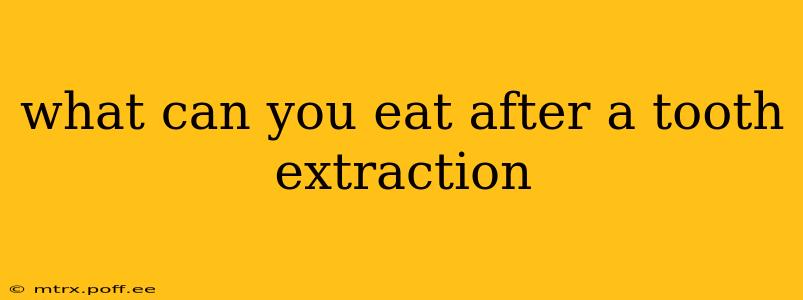What Can You Eat After a Tooth Extraction? A Guide to Healing and Nutrition
Losing a tooth, whether through extraction or accident, is a significant event. Your body needs proper nutrition to heal, but the post-extraction period demands a careful approach to diet. This guide explains what you can and cannot eat after a tooth extraction, focusing on foods that promote healing while minimizing discomfort and risk of complications.
Understanding the Healing Process:
After a tooth extraction, a blood clot forms in the socket where the tooth was removed. This clot is crucial for healing and preventing a painful, serious condition called dry socket. Therefore, the first few days are critical for protecting this clot and allowing it to properly form. This means avoiding anything that could dislodge it.
Foods to Eat After Tooth Extraction:
The key is to consume soft, easily chewed foods that won't disturb the extraction site. Here are some excellent options categorized for easier understanding:
Immediately Following Extraction (First 24 Hours):
- Broths and Soups: Nutrient-rich, easy to swallow, and cool on the extraction site. Choose clear broths or soups with minimal solids.
- Applesauce: Smooth and creamy, providing essential nutrients without causing irritation.
- Yogurt (Plain): Provides protein and probiotics for gut health, essential for overall recovery. Avoid yogurt with chunks or large pieces of fruit.
- Ice Cream (Soft Serve or very soft): A comforting option for pain management, but choose soft varieties to avoid putting pressure on the socket.
- Popsicles: Cooling and soothing, but choose non-acidic varieties.
Days 2-7 (As Healing Progresses):
- Mashed Potatoes: Easy to chew and digest, offering essential carbohydrates for energy.
- Scrambled Eggs: Good source of protein for tissue repair.
- Oatmeal: Soft and easily digestible, providing fiber and energy.
- Well-Cooked Pasta: Opt for soft pasta shapes and avoid anything with hard or crunchy pieces.
- Pureed Vegetables: Ensure they are well cooked and blended to a smooth consistency.
- Smoothies: Blend fruits, vegetables, and yogurt for a nutrient-rich option. Make sure there are no large pieces.
Foods to Avoid After Tooth Extraction:
Avoid anything that could dislodge the blood clot or irritate the healing site. This includes:
- Spicy Foods: Can cause irritation and inflammation.
- Acidic Foods: Lemons, oranges, tomatoes, etc., can cause pain and discomfort.
- Hard Foods: Avoid anything requiring excessive chewing like nuts, chips, or hard candies.
- Hot Foods: The heat can increase pain and inflammation.
- Foods with Small Seeds or Pieces: Sunflower seeds, sesame seeds, poppy seeds can easily get lodged in the socket.
- Alcohol and Smoking: These can hinder the healing process and increase the risk of dry socket. Avoid both for at least a week.
H2: What if I develop a dry socket?
Dry socket (alveolar osteitis) is a painful complication that occurs when the blood clot is dislodged from the extraction site. Symptoms include severe pain, a bad taste in the mouth, and a visible empty socket. If you suspect you have a dry socket, contact your dentist immediately. They can provide treatment to alleviate the pain and promote healing.
H2: How long should I avoid certain foods?
The duration of dietary restrictions depends on the complexity of the extraction and your individual healing process. Most dentists recommend a soft food diet for at least the first week. As your healing progresses, you can gradually reintroduce more solid foods. Always listen to your body and avoid anything that causes pain or discomfort.
H2: What about drinking through a straw?
Using a straw creates suction, which can dislodge the blood clot. Avoid using straws for at least a week after the extraction.
H2: Is there anything else I should do to promote healing?
Following your dentist's post-operative instructions is crucial. This often includes rinsing gently with saltwater, taking prescribed medication (if any), and keeping the extraction site clean. Good oral hygiene, including regular brushing and flossing (gently around the extraction site), is essential. Proper rest and hydration also contribute to faster healing.
Remember, this information is for general guidance only. Always follow your dentist's specific recommendations for post-extraction care. If you have any concerns or questions, contact your dental professional.
